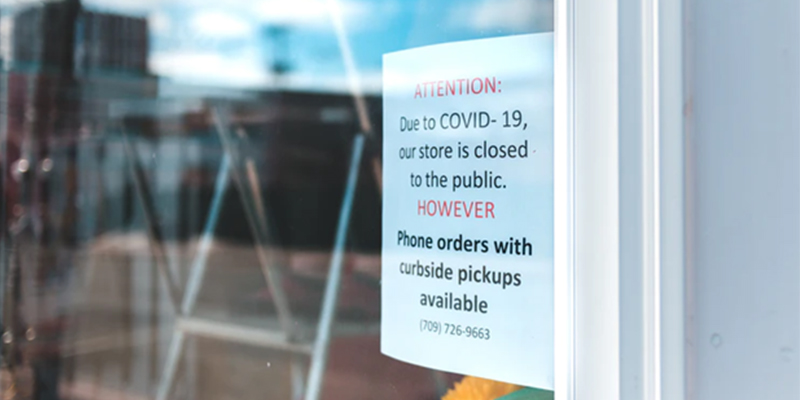In the strange new reality of life during the COVID-19 pandemic, social distancing, face masks, and limited capacity seating are now part of everyday life. But as eager as we are to get back to our pre-COVID habits, the reality is that some aspects of our “new normal” may last years or even a lifetime.
One of these aspects is shopping behavior in retail spaces. While the virus may soon be manageable through vaccines, the public has been left with an unshakable new awareness of the risk of germ transfer while shopping.
Unsurprisingly, online sales have soared since the start of the pandemic, effectively replacing many brick-and-mortar locations that have been forced to close their doors for good. While there is no doubt that the pandemic has wreaked havoc on in-person retailers, there is still light at the end of the tunnel.

Surveys show that total retail sales are already recovering to pre-pandemic levels, as seen in the graph above of total retail sales in Great Britain. In-person shopping has shared a healthy percentage of this upswing, with many shoppers preferring the benefits of in-person shopping. These include viewing items in-person, taking them home the same day, and discussing products with store clerks.
There is still ample opportunity for in-person shopping to survive and prosper post-COVID, provided that retailers are prepared to invest in long-term adaptations to the physical design of their stores. Since customers’ wariness of crowds is unlikely to fade anytime soon, retailers will need to pay close attention to the design of their space.
As stores begin to fully reopen, there are two main components of post-COVID retail design that need to be addressed: physical safety and psychological comfort. While physical safety is a top priority from a public health perspective, stores will not be able to survive if they do not also address the psychological aspect of consumer safety as well.
Permanent Safety Precautions

Most stores have already implemented a number of short-term safety precautions like plastic or acrylic counter guards, mask mandates, and social distancing markers on floors at check-out registers. As we transition into a “post-COVID” era, retailers will need to begin to think about adapting these temporary precautions to become more permanent features of the retail space.
Part of this adaptation simply means converting inexpensive, temporary materials into more long-lasting, attractive and durable materials. Acrylic counter guards, once considered a temporary measure, may become more permanent fixtures in stores by substituting materials like glass panels and stainless steel attachments. Retailers may want to consider replacing high-touch surface materials with a naturally germ-resistant metal such as copper. This method was used for decades in hospitals to prevent the spread of harmful viruses.
Other permanent solutions include incorporating design features to mitigate large crowds while facilitating foot traffic. Movable installations such as in-store kiosks are one such feature.
Self-service options may prove crucial for larger retailers that can afford the technology. Airports have been using check-in kiosks long before COVID-19 to reduce long lines and crowds. The same principle is easily transferable to the retail space. Self-service options mimic the experience of online shopping while allowing customers to view their items in person and taking them home the same day. Customers who already know what they want can quickly locate items by browsing inventory at individual kiosks. Hand sanitizer should be provided at every station, with adequate space between each self-checkout kiosk.
Curbside pickup is another desirable feature, which allows customers to pick up their items the same day and avoid spending time in a crowd. Some larger retailers like Target have already implemented curbside pickup. However, common customer complaints include long wait times and poor communication. As curbside pickups become increasingly in-demand, stores may need to dedicate more resources and staff power to ensure a positive customer experience.
Converting stockrooms into storage spaces can help accommodate the increased demand for curbside pickups and remote customer shopping. Many retailers have found that home delivery has been a lucrative feature throughout the pandemic. Customers can receive their items on the same day without the inconvenience and risk of leaving their home.
To accommodate these new features into brick-and-mortar shopping, retailers should consider adding organizational and storage features dedicated to home deliveries and in-store pickups into their stockrooms. An organized space with ample shelving will help ensure a smooth flow of pickups and home deliveries.
Facilitating traffic flow is another important aspect of retail design that should be considered a long-term adaptation to the post-COVID era. New retailers and those who can afford to hire an architect should work with a specialist to design a space that facilitates a one-way traffic flow throughout the store. Wider spaces, socially-distanced aisles and checkouts, and use of sanitary materials are all important features in post-COVID retail design.
Post-COVID Shopper Psychology

While safety should be the top priority of all retailers, brick-and-mortar locations will not be able to survive unless customers feel comfortable shopping in their space.
In many ways, facilitating a positive post-COVID shopping experience simply means making existing safety precautions highly visible to shoppers. Ample signage is one way to broadcast adherence to safety standards. Mask requirements should be on display at the front of the store. Other signs should explain enhanced cleaning standards and safety precautions, such as limiting store capacity.
Other measures include making hand sanitizer available throughout the store and providing wipes by shopping carts. Clothing stores should include additional features like makeup shields in dressing rooms for those trying on clothes.
Separating sanitized pens from used pens at the checkout counter is another way to visibly display stores’ dedication to impeccable standards of cleanliness. By visibly demonstrating high standards, stores will facilitate customers’ sense of safety.
Retailers should work with professionals to optimize their space for the post-COVID reality. By consulting with a dedicated team of architects, consultants, and interior designers, retailers can ensure that they will not only survive but thrive in our new normal. Let us know in the comments below how you are optimizing your retail space to the post-COVID reality.
Featured image from Unsplash.








